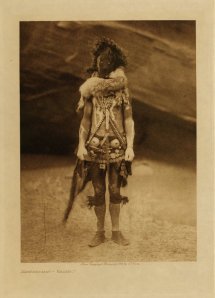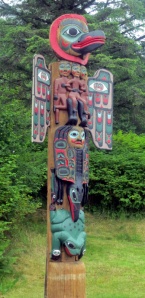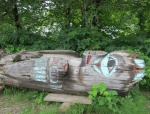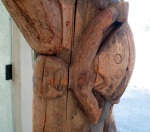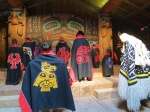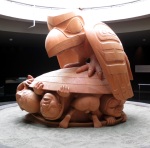Posts Tagged ‘mythology’
The Orphan Hero
In contemporary popular society, most of the big heroes are orphans.
That may sound like a bold claim, but consider a few of the countless examples: Luke Skywalker, James Bond, Harry Potter, Superman, Batman, and Spider-man. How many blockbuster films do these six characters represent? I haven’t counted, but it’s around fifty, grossing many billions of dollars. That’s to say nothing of the books, comic books, toys, accessories and video games.
J. R. R. Tolkien’s Lord of the Rings trilogy features not one, but two orphaned principle protagonists: Frodo Baggins and Aragorn. Tolkien was himself an orphan.
The ten highest-grossing films of all time, adjusted for inflation, are:
Gone with the Wind
Avatar
Star Wars
Titanic
The Sound of Music
E.T. the Extra-Terrestrial
The Ten Commandments
Doctor Zhivago
Jaws
Snow White and the Seven Dwarves
Both of young Scarlett O’hara’s parents die in Gone with the Wind. Luke Skywalker and Princess Leia are both orphans. Jack Dawson, played by Leonardo di Caprio in Titanic, was orphaned at a young age.
Maria von Trapp in The Sound of Music was an orphan, and the film is largely about the missing mother figure in the Trapp family.
Divorce and abandonment by the father feature prominently in E.T. The Wikipedia article on the film, with citation to the biography of Stephen Spielberg by Joseph McBride, states that the alien was based on an imaginary friend Spielberg invented after his parents’ divorce in 1960. “Spielberg said that E.T. was ‘a friend who could be the brother I never had and a father that I didn’t feel I had anymore.'”
Moses? Found in a river, raised by Pharaoh’s daughter. Yuri Zhivago? Orphan, taken in by his mother’s friends after she died. Snow White lived with her wicked stepmother.
That leaves only Jaws and Avatar. Jaws, I grant you, has no obvious connection to orphans. Avatar doesn’t deal explicitly with orphans, but the primary theme is about its hero finding his real family and true identity.
So, out of the ten top-grossing films of all time, seven of them are about orphans, and two of the remaining three (E. T. and Avatar) have core themes of child abandonment.
***
Clearly there is something about the orphan motif that works for people – so much so that it has become the acme of the hero category.
No single factor can account for this fact. However, several possibilities represented by the orphan character, both on the story level and symbolically, tend to work very well. I believe the combination of story opportunities that the orphan situation provides can account for the popularity of the type.
At the most basic level, the orphan arouses our natural sense of sympathy. Orphans are, after all, children who have suffered a great loss that anyone can understand.
In fiction, orphan characters often grow up feeling isolated and vulnerable. They may achieve wisdom and maturity beyond their years because of the hardship and loss they have had to bear at an early age.
The loss of the parent may give the orphan hero an idealistic commitment, as in the case of Spider-man. Peter Parker was orphaned a second time by the death of his kindly Uncle Ben – a death for which he bore some sense of responsibility. It is easy to accept that an experience like that could form a passionate commitment to justice that would change the course of his life, having learned from his uncle that “with great power comes great responsibility.”
We see similar developments at work in the comic book heroes Tony Stark (Iron Man) and Bruce Wayne (Batman).
As described in the Ian Flemming novel You Only Live Twice, James Bond lost his parents at an early age, leaving him a maladjusted youth who found a surrogate parent of sorts in his service to Queen and Country.
The longing for lost parents or the quest for a substitute reflects a universal longing for security and home. This mood is developed vividly in Dr. Zhivago, in which Yuri’s peregrinations reach an apex of poignancy when he returns to the childhood home where his mother passed away.
***
For those of us who are not orphans, the character may reflect the intuition that we live in a world filled with problems that our parents did not prepare us to confront. The new face of warfare, climate change, economic challenges and disasters – every generation finds itself in a brave new world, and anyone can be disillusioned by the world they inherit.
A world without parents is a world in which we are left to our own devices, and must understand and confront whatever dangers await us. This sense of peril and self-reliance is a central heroic theme. We see it developed, for example, in the Harry Potter series, in which Harry’s development is followed from his youth, during which he lives under the magical protections his parents and guardians bequeathed to him, to his maturity, in which he is increasingly exposed to danger, and must set things right through his own initiative and achievement.
This transition is dramatized by Harry’s confrontation with the newly-returned Voldemort at the midpoint of the saga, Harry Potter and the Goblet of Fire.
Through a magical effect that Rowling calls priori incantatem, which is apparently Latin for “transparent plot device,” the ghosts (sort of) of Harry’s parents come to his aid at the moment of crisis. But when they depart, their protection is withdrawn. In the fifth and sixth novels, he loses his godfather and his mentor, and by the final novel, he is solely responsible for confronting the evil he finds in the world.
This theme finds an interesting parallel in the novels of James Joyce, which, it goes without saying, are creative works of an entirely different order. Nevertheless, the primary creative agent in Joyce’s Portrait of the Artist and Ulysses is Stephen Dedalus. Although he has a father, and could even find a second in Leopold Bloom, should he wish to, he rejects both, preferring to create for himself a space without fathers; that is, without precedent or constraint, in which he can create.
In the symbolic language of Nietzsche’s Thus Spoke Zarathustra, the rejection of the father is the slaying of the dragon, a beast who says “Thou shalt,” with its very being. This heroic deed is the necessary prelude to the creative life.
So, in many cases, the orphan embodies the self-reliant, creative adult. It is tempting to posit this as a particularly American idiom, one which reflects the country’s mythology of self-reliance, and its status as a land without history. This may be at work in some cases, such as Superman, who is arguably the quintessential hero of the 20th century. However, we also have the cases of the Irish James Joyce and the English Rowling, Flemming, and Tolkien.
***
On the mythological plane, the orphan is frequently a character of great and hidden ancestry or lineage, and it is often the discovery of the unknown lineage that sets the hero on their adventures.
We find this in Luke Skywalker, of course, who wants to learn the ways of the Force, like his father.
Harry Potter learns to his delight that he’s no mere Dickensian orphan, but a magician of proud parentage. Superman learns about his family on the planet Krypton when he comes to maturity, and this discovery sets him on his quest for truth, justice, and the American way.
The secret lineage motif represents the duality of our public and private identities. Our public face – or “secret identity,” in comic book language – is a socially-constructed, socially-approved fiction, in which we work menial jobs for the Daily Bugle or Planet, and have a hard time getting a date.
But in our actual, inner lives, and with respect to our true inheritance, we are luminous beings, the children of kings and gods, which are themselves merely mythological projections of idealized human values.
We could easily excavate countless exemplars of this motif, such as the Grail hero Parzifal of Wolfram von Eschenbach’s epic. Raised in the forest by his mother Herzeloyde, Parzifal knew nothing of his own heroic father Gahmuret, who was a famous knight. He did not even know of the existence of knights, until one day he stumbled upon one traveling through his forest.
Parzifal, the young rube, beheld the splendid knight in bright armor, and thought that he had met a god. And so he had, for here in outward form was the living reflection of his own inmost potential.
This motif is not confined to the traditions of Europe. In the mythology of the Apache and the Navajo, for example, the two great culture heroes are twins named Slayer-of-Monsters and Child-of-the-Waters. Accounts of their childhood differ, but in all cases they learn, upon reaching a certain age, that their absent father, whom they have never known, is the Sun, who dwells in his mansion far to the east.
So they begin their extraordinary journey to meet with their father. They overcome many obstacles on the way, and, when they reach that far-off mansion, they are tested by their father, who accepts them and teaches them the bow and arrow, and the names of the plants and animals, and how to behave like human beings.
I cannot help but be reminded of the Gospel of Thomas, in which it is written “When you know yourselves, then you will be known, and you will understand that you are children of the living Father.”
Interpreting Religious and Mythological Symbols
“Myths are the norms of the unreasonable.” – James Hillman
I would like to start by relating a beautiful little cosmological myth drawn from the Hindu Kūrma Purāṇa. It was written down sometime during the first millennium CE, the golden age of Sanksrit literature that bore the great epics, the Mahābhārata and Rāmāyaṇa, as well as some of the finest Sanskrit poetry and plays.
At the end of the last Aeon when the three worlds were in darkness, there was nothing but a solitary sea, no gods and nothing divine, no seers. In that undisturbed emptiness slept the god Vishnu the Supreme, lying on the back of a great serpent. He was vast like a dark cloud, the soul of Yoga that dwells in the hearts of yogins.
Once during his sleep there arose in play from his navel a pure lotus, wondrous and divine, core of the three worlds. Spreading out a hundred leagues, bright as the morning sun, it had a heavenly fragrance, and was crowned with an auspicious calyx and stamen.
The lord Brahmā approached the place where Vishnu had long been laying. The Eternal-Souled Brahmā brought Vishnu upright with a gesture of his hand, even as he became mesmerized by the great god’s display. He spoke these sweet words: “Tell me, who are you, lying hidden in darkness in this dreadful, desolate sea?”
Vishnu smiled and answered, his voice like thunder. “Ah! Ah! Know me to be the great god Vishnu, creator and destroyer of the worlds, lord of yoga, the supreme person. See entire worlds within me, the continents with their mountains, the oceans and the seven seas, and also yourself, grandfather of worlds.”
Vishnu asked, though he already knew, “And who are you?” Laughing, the lord Brahmā, keeper of the Vedas, with lotus eyes, replied “I am the creator and ordainer, the self-existent ancestor; in me is everything established; I am Brahmā who faces all directions.
Hearing this, Vishnu, whose power is his truth, took his leave and entered into the body of Brahmā by yoga. Seeing all three worlds with gods, demons and men in the belly of the god, he was astonished.
And Brahmā laughed, and entered into Vishnu in turn. He saw these worlds in the womb, and moving about inside the great god, he saw no end or limit. At last he traveled out through Vishnu’s navel, and was born from a golden egg, the four faced Brahmā who had entered therein by the power of his yoga. He displayed himself on the great lotus. Lord Brahmā, self-existent, Grandfather, womb of creation, lustrous as the insides of a flower, shone there radiantly, resting on the lotus. (1)
The Hindu poets have a splendid vision of the vast magnitude of the cosmos, one that resonates well with the picture of the universe that we have today. Anyone who has marveled at the pictures from the Hubble telescope will recognize the sense of infinity and wonder, the stars and galaxies spiraling out endlessly through the void.
But Vishnu is the “supreme person,” the exemplar or archetype of our own individual egos, and somehow all of that magnitude is also within us. This, too, is increasingly the recognition of our greatest scientific minds. As Albert Einstein observed:
A human being is a part of the whole, called by us “Universe”; a part limited in time and space. He experiences himself, his thoughts and feelings as something separated from the rest—a kind of optical delusion of his consciousness. This delusion is a kind of prison for us, restricting us to our personal desires and to affection for a few persons nearest us. Our task must be to free ourselves from this prison. (2)
One of the cardinal insights offered by the high mythological traditions is precisely this: all of the gods and demons and all of limitless space together form a symphonic interplay that is rendered as a unified experience by your own mind. The world in which we live is given from without, but also brought forth from within, and the power of the yogic traditions is to unite these two realms into a single image.
Nobel laureate Erwin Schödinger wrote:
The reason why our sentient percipient, and thinking ego is met nowhere within our scientific world picture can easily be indicated in seven words: because it is itself that world picture. It is identical with the whole and therefore cannot be contained in it as a part of it. But of course, here we knocked against the arithmetical paradox; there appears to be a great multitude of these conscious egos, the world, however, is only one. This comes from the fashion in which the world-concept produces itself. The several domains of ‘private’ consciousnesses partly overlap. The region common to all where they all overlap is the construct of the ‘real world around us.’ With all that an uncomfortable feeling remains, prompting such questions as: is my world really the same as yours? […]
Such questions are ingenious, but in my opinion, very apt to confuse the issue. They have no adequate answers. They all are, or lead to, antinomies springing from one source, which I call the arithmetical paradox; the many conscious egos from whose mental experiences the one world is concocted. The solution of this paradox of numbers would do away with all the questions of the aforesaid kind and reveal them, I dare say, as sham-questions. (3)
Compare to Eihei Dogen, the thriteenth-century founder of Soto Zen: “The buddha way is, basically, leaping clear of the many and the one.” (4)
A functioning mythological or religious symbol presents images of this kind in a way that people understand outside of the intellect. When we resonate with their imagery, mythological symbols work a kind of magic on us that has nothing to do with intellectual understanding. Anyone who has been swept away by Homer’s Odyssey, or felt sorrow at Christ’s crucifixion, or been uplifted and inspired by the life story of the Buddha, has felt this magical effect.
However, there is a lot to be said about mythological symbols and how they function, without trying to explain them. Just as a skilled musicologist can enhance our appreciation of a string quartet by calling our attention to its formal features, just as a film critic can make us think about movies in a different light, a consideration of how religious symbols function can greatly illuminate our understanding of the field.
The first essential point to be made with respect to mythological symbols is that they are symbols, and do not function as factual descriptions about the world.
When we are in the realm of empirical description, the realms of science and history, our statements are constrained by Aristotelian logic; things are either this or that. In the realm of symbols, however, that kind of logic does not apply. Brahmā is within Vishnu; Vishnu is within Brahmā. I am within you, you are within me.
“What is the divine?” asks the student in the Bṛhadāraṇyaka Upanishad. “Neti, neti,” answers Yajnavalkya the sage. “Not this, not that.”
Religious and mythological forms are expressive of truths of human consciousness, and the degree to which they correspond to the actual state of affairs is entirely irrelevant to their character and effect. To interpret them as factual descriptions of reality is to miss the point entirely.
Consider the statement “Claudius killed Hamlet’s father.” Is it true or false? It is true insofar as it accurately describes what happened in Shakespeare’s play. But in a sense, it is neither true nor false, because it refers to people who never actually existed.
In other words, how we evaluate statements depends on what we mean by “true” in a specific context. Our criteria for truth differ according to what we’re talking about. When we’re discussing a play by Shakespeare, we tacitly agree to discuss it as if it refers to actual events. This is quite a different matter from evaluating the truth of, say, the theory of evolution by selective adaptation.
And there is a kind of truth in Hamlet, even though it is not an empirical truth. I have read Hamlet many times and have learned a great deal about myself and about the world, even though I’ve learned nothing about the history of Denmark.
The psychologist R. A. Hunt distinguished between three attitudes that people take with respect to religion; he called them literal, antiliteral, and mythological perspectives. (5)
Literalism simply means interpreting religious symbols and stories at face value, and accepting them as factual descriptions of the world. Someone with an antiliteralist perspective also interprets religious symbols as empirical statements, but rejects them as factually incorrect.
The mythological stance engages in a creative interpretation of religious statements in an attempt to understand their deeper meaning. Someone with this attitude asks of symbolic material, what is it getting at?
In our preceding example, the literalist would insist that there actually was a Hamlet, a prince of Denmark, and he actually saw the ghost of his father. Never mind what we know about history, or the literary sources for Shakespeare’s play, such as Thomas Kyd’s Spanish Tragedy.
The antiliteralist rejects the whole thing, because there is no such thing as ghosts. In fact, Shakespeare is a waste of time, and reading this material is dangerous, because people get swept up in the drama and the emotion, even though the play literally means nothing.
It concerns me very much to see that the prevailing attitudes in my society are literalism and antiliteralism, with the former primarily represented by Biblical literalism, and the latter represented by increasingly-scornful forms of science-minded atheism. In my evaluation, both approaches are equally incorrect, because both read symbolic statements as if they were empirical.
The mythological systems that we have inherited simply cannot be accepted at face value, given what we know to be true on the basis of our scientific findings. The world is not six thousand years old, the Israelites did not come out of bondage from Egypt in the wake of national catastrophes, the world is not made up of four continents arrayed around a central cosmic mountain, as the Buddhists have taught. These are things that we know.
Neither can mythological symbols be simply rejected on this count, because they encompass other kinds of truth. Mythology and religion deal with a sphere of human nature that is ubiquitous and profound, and of great concern to nearly every known human society throughout history. It is a language that speaks directly to the psyche, and it illuminates aspects of human experience that lie beyond the ordered domain of the rational intellect.
If we try to wave the problem of religion away, as many do when they identify strongly with the rational intellect, then we leave ourselves at the mercy of the unconscious forces within ourselves that respond to symbols and images.
I’ve never seen this more clearly illustrated than in the career of Sam Harris, author of several prominent books on atheism, which are transparently motivated by his fear of the irrational. The degree to which his life concerns are motivated by fear of attack is obvious to any reader of his long article on self-defense, or this debate with security expert Bruce Schneier, in which he simply dismisses every rational, pragmatic objection to screening people who look like Muslims.
Yet he is the rational one, he insists.
We cannot ignore the power of the irrational mind, because it is a part of all of us. Its vocabulary is symbolic, not literal. Joseph Campbell made this point in an arresting way:
Clearly mythology is no toy for children. Nor is it a matter of archaic, merely scholarly concern, of no moment to modern men of action. For its symbols (whether in the tangible forms of images or in the abstract form of ideas) touch and release the deepest centers of motivation, moving literate and illiterate alike, moving mobs, moving civilizations. There is a real danger, therefore, in the incongruity of focus that has brought the latest findings of technological research into the foreground of modern life, joining the world a single community, while leaving the anthropological and psychological discoveries from which a commensurable moral system might have been developed in the learned publications where they first appeared. For surely it is folly to preach to children who will be riding rockets to the moon a morality and cosmology based on concepts of the Good Society and of man’s place in nature that were coined before the harnessing of the horse! And the world is now too small, and men’s stake in sanity too great, for any of those old games of Chosen Folk (whether of Jehovah, Allah, Wotan, Manu, or the Devil) by which tribesmen were sustained against their enemies in the days when the serpent still could talk. (6)
***
Have you ever stepped into a Gothic cathedral? Many people feel an immediate and striking transformation of their attention and mood. Your eyes travel upward, tracing the soaring unbroken columns into the vault of shadow and light, and your mood becomes contemplative. The feeling is like Denise Levertov’s experience walking among great trees:
… my attention now
caught by leaf and bark at eye level
and by thoughts of my own, but sometimes
drawn to upgazing – up and up: to wonder
about what rises
so far above me into the light. (7)
Last year I read The Gothic Enterprise by the sociologist Robert A. Scott, and heard him lecture. I was amazed to find that he put aside all questions concerning the aesthetic, psychological or spiritual effects of the cathedral, focusing exclusively on the social phenomenon.
He wrote a perfectly good book, and there is nothing wrong with a sociological analysis of cathedrals and cathedral-building. But I was amazed that a scholar and academic would write a book on the subject, ignoring the single most salient fact about them: they produce a profound effect on a great many people. It is as though the objective, scientific way to study a lion is to treat it as if we don’t really know if it’s alive or not, and simply study the physics.
The wonderful video artist Bill Viola, in an interview with Jörg Zutter, also talked about cathedrals:
[I]n Florence I spent most of my time in pre-Renaissance spaces – the great cathedrals and churches. At the time I was very involved with sounds and acoustics, and this remains an important basis of my work. Places such as the Duomo [Cathedral of Florence] were revelations for me. I spent many long hours staying there inside, not with a sketchbook but with an audiotape recorder. I eventually made a series of acoustic records of much of the religious architecture of the city. It impressed me that regardless of one’s beliefs, the enormous resonant stone halls of the medieval cathedrals have an undeniable effect on the inner state of the viewer. And sound seems to carry so much of the feeling of the ineffable.
Acoustics and sound, a rich part of human intellectual and speculative history, are thoroughly physical phenomena. Sound has many unique properties compared to an image – it goes around corners, through walls, is sensed simultaneously 360 degrees around the observer, and even penetrates the body. Regardless of your attitudes towards the music, you cannot deny the thumping and physical vibrations in your chest cavity at a rock concert. It is a response beyond taste. When I discovered standing wave patterns, and the fact that there is a total spatial structure of reflection and refraction, a kind of acoustic architecture in any given space where sound is present, and that there is a sound content, an essential single note or resonance frequency latent in all spaces, I felt I had recognized a vital link between the unseen and the seen, between an abstract, inner phenomenon and the outer material world. (8)
It is perfectly possible to give a rational, enlightening account of cathedrals, if you approach the problem like an artist, asking what things mean and how they communicate. Otherwise you hit a brick wall, like our sociologist.
The intellect can shed light on mythology, but ultimately you have to hear the music. Viola again:
There is still such a strong mistrust in intellectual circles about things which speak to the mind via the body. It’s as if they can see that this direction will ultimately lead to opening the locked gate to the forbidden zone of deeper emotional energies. In my opinion, the emotions are precisely the missing key that has thrown things out of balance, and their restoration to their rightful place as one of the higher orders of the mind cannot happen fast enough. (9)
For a profound testimonial to the degree to which Viola heard and understood the message of the cathedral, I strongly urge watching this short video on Ocean Without a Shore, about a recent installation piece he did in Venice.
A vital domain of human experience is available by living in relationship to symbols, and there is no other way to get at it. The primary interpretive tools of this realm are similar to the tools used to analyze literature, poetry, music and philosophy, because these forms have a common genesis. They are expressive of the energies of the psyche.
References
1) Based on “The Origin of Brahmā from the Lotus in Viṣṇu’s Navel,” in Dimmitt CD and van Buitenen JAB. Classical Hindu Mythology; A Reader in the Sanskrit Purāņas. Temple University Press. 1978. pp. 30-1.
2) Quoted in Wilber K. Up from Eden; A Transpersonal View of Human Evolution. Shambhala. 1983. pg. 4.
3) “The Oneness of Mind,” by E Schrödinger. Quantum Physics; Mystical Writings of the World’s Great Physicists. ed. Ken Wilber. Shambhala. 1984. pp. 84-9.
4) “Actualizing the Fundamental Point,” trans. by Robert Aiken and Kazuaki Tanahashi. Moon in a Dewdrop. ed. Kazuaki Tanahashi. North Point Press. 1985. pp. 69-73
5) Hunt RA. “Mythological-symbolic religious commitment: The LAM scales.” Journal for the Scientific Study of Religion, 11, 42-52. 1972.
6) Campbell J. The Masks of God Volume I: Primitive Mythology. Penguin Books. 1969. pg. 12.
7) “From Below,” by Denise Levertov. This Great Unknowing; Last Poems. New Directions Books. 1999. pg. 3.
8) Viola B. “In Response to Questions from Jörg Zutter, 1992.” from Reasons for Knocking at an Empty House; Writings 1973-1994. The MIT Press. 2002. pg. 241.
9) Ibid., pg. 242.
All images (c) Barnaby Thieme, unless otherwise noted.
Totem Poles of the Pacific Northwest
Note about Pictures: In order to make room for so many photographs, I’ve had to use thumbnails – I hope readers will click on some of them to see them full-sized.
The coastal region of the Pacific Northwest, stretching from the Alaskan panhandle in the north to Vancouver Island in the south, has been home to indigenous peoples for thousands of years, including the Tlingit (pronounced kling-KIT), Haida, Tsimshian and Kwakiutl.
These are different groups with distinct histories and languages, but they share deep similarities of culture, religion and art, which combine to constitute what the great anthropologist Franz Boas has called “one of the best defined cultural groups on our continent.” (Social Organization and Secret Societies of the Kwakiutl, 317) I will speak most frequently of the Tlingit, but draw upon other groups participating in this common cultural heritage as well.
One of the most striking features of this cultural zone is what we will call totem poles for lack of a better term. The word “totem” comes from the Ojibwe word for “kinship group,” and does not properly belong to the region. The Tlingit term is kootéeyaa, but several natives I have spoken with used the term “totem pole,” so I will follow their lead.
Originally, most totem poles were probably carved into the pillars of clan houses, like the great totems flanking the magnificent Beaver screen in the Tlingit Beaver Clan House of Saxman, Alaska (shown to the right). Short, free-standing totem poles were also placed in the woods, used to house the cremated remains of venerated persons.
When Russian and European fur traders arrived in the nineteenth century and metal tools became widely available, it became possible to carve much larger poles. These massive poles, sometimes dozens of feet high, were commonly erected along waterways, as the people inhabited narrow strips of land between the coastal mountains and the sea, or in densely-forested river valleys, and traveled by water.
The oldest surviving poles date to the mid-nineteenth century, and those are relatively few in number. Poles are usually carved of cedar, which does not preserve well. However, my understanding is that the demise of a pole is regarded as the completion of its life cycle, not a tragic loss.
Totem poles are emblazoned with figures called crests, which are usually animals, mythological beasts or legendary ancestors. Crests form an integral part of the social and symbolic economy of the Pacific Northwest and are core features of social identity. A crest may only be displayed by a family that owns the right to the crest, and those rights are passed down.
One interesting exception to that rule is the owl crest, shown to the right, which is not inherited and may only be displayed by a shaman.
Crests often signify historical or legendary episodes that help define the identity, status and privileges of a family. The world of songs, legends and myths is intimately bound up with crests, which may explain where the clan came from, why they have the right to fish in a particular stream, and so forth.
Let’s take a look at the striking Eagle Halibut pole of Laay, currently on display at the Museum of Anthropology at the University of British Columbia in Vancouver, to get a sense of how the symbolism works. The interested reader will find the full account of this complex pole here, but I will only focus on part of it.
To the right you will see two crests that combine to form a single composite image at the base of the pole. The smaller crest depicts a hero named Gunas being devoured by a large halibut, and that image is set onto the chest of a larger figure, an intense-looking figure called Hagwil̓ooḵ’ who carries a bent-wood box on his head.
This is a memorial pole for the Tlingit Chief Laay, who led his people out of their original home in Alaska to the village of Gwinwoḵ on the Nass River in Canada. While they were traveling to their new home, Gunas went swimming in the clear waters near Cape Fox, when he was suddenly attacked and swallowed whole by a giant halibut.
Richard Morgan tells the story:
Everybody got excited, you know, when they saw the huge halibut. They called for Supernatural Halibut and they called for Supernatural Eagle to help them. And the eagle [was] sitting right at the point, and the next thing you know, the eagle managed to get the halibut ashore and capture the halibut. And they cut the halibut open, but the body of Gunas, the remains of the body, [were] already decayed, so they sing a dirge song, funeral song about Gunas being captured alive by a halibut.
This account is typical of crest legends in several ways. It links an episode of the legendary past with a story and a song, and establishes the debt owed by the halibut to the clan. The Gunas crest connects the Nisg̱a’a Tlingit to halibut fishing – Gunas paid for the crest with his life. Crest stories frequently involve someone owing a debt, or violating a taboo or getting into a disagreement with an animal power or deity, and being killed. This death creates a new debt in the symbolic economy, and and the family earns the right to a story, or song, or place, or the right to hunt a particular animal, et cetera.
The concepts of debt and exchange are extremely important in the Pacific Northwest, as we saw previously when we looked at shame poles, which are erected to commemorate unpaid debts. The flip side of this is that if you want to fish, your family needs to have the moral right to fish, and it often seems to be established in stories of this kind.
There is a deeper mythological sense to this pair of images as well. Gunas and his halibut are engraved on the chest of this scary-looking Hagwil̓ooḵ’ fellow. Morgan explains this figure thusly:
And as they [were] traveling, they encountered a huge man from under water. It has a tail of a salmon. It came up with huge spring salmons, huge seafood, a lot of seafood. They call it Hagwil̓ooḵ’. That’s a symbol you will see on the bent boxes. Anybody who is really aggressive, get a lot of food for families, they call them Hagwil̓ooḵ’.
The paired crests of this pole combine the two aspects of the Great Hunt in a single image – we see both predator and prey. The Nisg̱a’a has paid for the right to catch fish with their own flesh and blood; that is, they belong to the cycle.
We’ve looked at this basic tragic image several times in this blog, most recently in the Grimm Brothers story “The Juniper Tree” here. We’ve also looked at the symbol as it was expressed in Iron Age Greece here.
The Eagle Halibut Pole of Laay illustrates the whole symbolic economy of the Pacific Northwest. Clans are characterized by the of symbols that encode their history and establish their rights and powers. These crests are not only displayed on house pillars and totem poles, but found on ceremonial chilkat robes or button blankets worn during ceremonial dances. A Tlingit can tell at a glance where someone is from and what their lineage is, simply be looking at their regalia.
Despite various historical challenges and setbacks, the symbolic culture of the Pacific Northwest remains vital and active to this day. While indigenous populations were decimated by exposure to Old World diseases such as small pox, the numbers have now stabilized. The United States abandoned its disgraceful campaign to eliminate native languages and cultures in the region decades ago, and since the 1960s there has been a great revival of interest in native art and culture. So the old arts are carried on – to the right you can see Tlingit Master Carver Nathan Jackson at work on a new pole in his studio. He was the lead artist of the spectacular Beaver Clan House screen shown above.
Many new artists appear to be interested in incorporating new sources of inspiration and ideas. For example, the superb Kwakwaka’wakw artist Doug Cranmer spent several years in the 1960s using traditional compositional elements of the Pacific Northwest to create entirely abstract work without story or reference. I also enjoyed the work of Averyl Veliz that I saw at the Juneau-Douglas City Museum, such as her wonderful “Wolf in the Moon” (right).
A great example of the harmonious blend of old and new is The Raven and the First Men by Haida artist Bill Reid, currently on display at the University of Anthropology in Vancouver. This magnificent carving depicts a Haida myth of Raven acting as a kind of midwife for the creation of humankind.
Raven is a powerful shamanic trickster figure and is the culture hero of the entire vast region from the Kwakwaka’wakw of Vancouver to the Inuit of Alaska. His stories are especially connected with acts of creation and naming, and the story of how Raven stole the sun from heaven and ended the long darkness is an extremely popular subject. In my next post on the Tlingit and other traditions of the Pacific Northwest, I’ll have a closer look at the mythology of the region, with particular attention to Raven.
The traditions of the Northwest remain with us. Bertha Sleid Guan of the Kaagwaantaan Tlingit told me that in her village, public schools offer classes in the Tlingit language every day, and once a week, the entire school day is conducted in Tlingit. She described her sense of wonder at seeing a young Tlingit girl speaking in her own language with her schoolmate, a blonde-haired, blue-eyed girl of Norwegian descent.
I told Bertha that I had read many wonderful stories of the old days, like the story of how the Tlingit came to move out of their ancient home in Glacier Bay, which I read in the superb book Haa Shuká, Our Ancestors by Norma Marks Dauenhauer and Richard Dauenhauer.
As Susie James told those authors, the Tlingit used to live in peace and abundance in Glacier Bay. At that time, there was a young girl who was kept in seclusion behind her house. We learn from many ethnographers such as Kalvero Oberg that this was a common practice when Tlingit girls approached adolescence. They were sequestered for months or a year in a private little hut behind the family dwelling until they were presented as adults at a great feast or potlatch.
But this girl was kept there for three years, which is a very long time. One day she saw a glacier very far away, and perhaps because she was unhappy with her seclusion, she called to it like a dog, saying “Glacier, here, here.”
To everyone’s alarm, the glacier started to grow, started to advance on the Tlingit, fast, faster than a dog could run. Everyone saw it charging toward them and they got into their boats to flee, to leave Glacier Bay and find a new place to dwell — everyone except for grandmother who didn’t want to go. She said “I will stay here. Whatever happens to my mother’s maternal uncles’ house will happen to me.” So she stayed and gave her life to the glacier, and there is our debt.
When I spoke to Bertha, I told her I had read this story, and I wanted to know, how do the Tlingit hold these stories today? Are they valued as legends, or are they believed, the way history is believed?
She told me that it may be hard for you to accept that a glacier would run as fast as a dog, but we’ve researched the area and we know that the Tlingit of her village came down from Glacier Bay, and they regard it as their sacred home. The archaeological evidence indicates that the area was inhabited around 2000 years ago by a people evidencing cultural continuities with the Tlingit of today, until they were driven out by a long period of ice. When the glaciers receded after the end of the Little Ice Age in the Middle Ages, the Tlingit appear to have moved (back?) into the area.
She told me that there are many stories that can be told to outsiders, like the ones I read in my book, and many songs that are sung for anyone. But then there are stories and songs that are private, known to the families and houses, and those stories have a lot to say about the world, and who we are.
All photos are (c) Barnaby Thieme, except “Wolf in the Moon,” which is my photograph of a work by Averyl Veliz, who retains all rights.
Journey into the Dark; A note on the comparative study of religions and what I found there
The kurgarra sprinkled the food of life on the corpse.
The galatur sprinkled the water of life on the corpse.
Inanna arose….
It was around the time that I first saw Wagner’s Ring cycle that I decided in earnest to undertake a systematic, if necessarily cursory, comparative study of the major trends of history and culture in the world, with special attention to religious and mythological traditions. Wagner’s gargantuan and unparalleled dramatic imersion in the great mind of myth was a natural gateway to that journey.
Claude Levi-Strauss, the founder of structural anthropology, observed that “If one must see in Wagner the unimpeachable father of the structural analysis of myths … then it is highly revealing to note that such analysis was first made in music.” Like music, myth organizes and expresses non-rational energies and images of the unconscious in an expressive and emotional manner. Like music, myth has the power to transport one outside of one’s self.
The case of Wagner also warns of the dangerous possibilities of sailing the seas of the unconscious, as his troubling biography aptly testifies. Journeying outside the intellect leaves one vulnerable to the psyche, which holds the possibility of violence and darkness alongside the seeds of transformation and liberation.
However, positive and negative potentialities exist within the human mind whether they’re explored or not, and ignoring the irrational is no less dangerous. On the contrary, ignoring the nighttime within increases the possibility that one will be unwittingly directed by the shadow one excludes. In this sense, the exploration of the depths of the soul is a journey into darkness, with the hope that one may then return with the seeds of light. This is the unanimous testimony of the world’s rich heritage of myth, and it accords deeply with my own experience.
That this journey is fraught with peril is made clear by every myth we know, extending back to the earliest recorded stories set down in clay tablets in Sumer. From the myths of ancient Mesopotamia we learn of Inanna, the goddess of the Morning Star, who descends into the underworld, passing through seven gates. At each gate she is stripped of an ornament or garment, every token of her personality, until she arrives in the Land of the Dead, naked. There she is greeted and slain by her sister and double, Ereshkigal.
As so many have found, the loss of personal identity, which seems like the final crisis, instead became Inanna’s point of contact with the greatest of mysteries, that life extends beyond the individual ego. Through her resurrection, Inanna found that her persona is but a shadow of the true life she embodies, and out of the darkness Inanna finds new life.
Through this poem we achieve a sign that self-luminous being re-expresses itself through her new aspect in the patterns of her new identity, and the mind responds, for the deeper part of the self finds its own reflection in these stories. So in I Corinthians: “Behold, I shew you a mystery; we shall not all sleep, but we shall all be changed, in a moment, in the twinkling of an eye, at the last trump: for the trumpet shall sound, and the dead shall be raised incorruptible, and we shall be changed.”
Inanna’s descent was occasioned by her wish to console her sister Ereshkigal, whose husband, the Bull of Heaven, was slain by the hero Gilgamesh. The slain bull god and his consort have been the central signs of the resurrection for as far back as we can reckon. We find it in the Anatolian city of Çatal Höyük in the eighth millennium BCE, where death and rebirth are associated with the bull god whose horns are the crescent moon. This moon-bull-god of the Taurus mountains may well have its ultimate origin in the Lower Paleolithic, and is transmitted down to this present day, as Inanna gradually transforms into Ishtar, Isis, Astarte, Aphrodite, and the Virgin Mary.
While I was studying the literature of the Old Testament I learned that the Hebrew words of my name, Bar-nabe, meaning “son of a prophet,” were probably derived from an Akkadian root, the high literary language of ancient Babylon. I had a vertiginous sense of personal connection to that ancient and marvelous culture, mediated by a frozen artifact of language, transmitted over thousands of years in a lineage of speech linking me to the authors of the epic of Gilgamesh.
Language carries meanings over great expanses of time, and so too with religious symbols. They are the outer sign of an inner meaning, preserved in fixed structures as the details are altered over their long lives. The life of the spirit is fixed within them like an insect trapped in amber.
That life can speak to us from out of frozen forms and archaic stories precisely because they echo the inner life, and outward gradually leads inward, to the dark places of the self, the quiet resources where the immortal light shines.
From Rilke’s Book of Hours:
I love the dark hours of my being.
My mind deepens into them.
There I can find, as in old letters,
the days of my life, already lived,
and held like a legend, and understood.
Then the knowing comes: I can open
to another life that’s wide and timeless.
So I am sometimes like a tree
rustling over a gravesite
and making real the dream
of the one its living roots embrace:
a dream once lost
among sorrows and songs.
The Ancient Egyptian Afterlife Was a Bureaucracy Comparable to the DMV
“Few people have turned the collection of rents and gathering of taxes into subject matter for sacred art.” — Barry J. Kemp, Ancient Egypt, Anatomy of a Civilization

Servant woman grinding grain, Fifth Dynasty, Egypt
Phoebe A. Hearst Museum of Anthropology.
Image (c) Barnaby Thieme.
If Sumer is like a fire — hot, unmistakeable, elemental, and immediate — then Egypt is like a bolt of lightening — blinding, cool, and remote. The majesty of its monumental architecture and its vivid icons often possess a timeless quality that feel strikingly inhuman. But it only struck me while reading one of the “coffin texts” just how alien Egyptian values were from my own.
The coffin text was a short-lived genre of writings in the Fourth and Fifth Dynasties, inscribed on tombs, offering testimony on behalf of the deceased. They often include prayers, spells, and invocations to aid in judgment before the gods and to ease existence in the afterlife. This particular coffin text was a putative autobiography of one Weni, who served as an administrator in the court of Pepy I. The text is surprising in its prosaic details, as though hagiography best consists of recounting promotions and enumerating the people in one’s support staff. A representative excerpt from this short text:
“His Majesty appointed me as sole companion and overseer of the officials of the palace, and four officials of the palace who were there were dispossessed. I acted so that His Majesty praised me in carrying out bodyguard service, in preparing the royal road, and in carrying out the (royal) stations. I acted to perfection, so that His Majesty praised me because of it more than anything.”
This text, engraved on the man’s coffin, was written for the gods. Presumably, then, these facts were believed to be of interest to those immortals who would decide how to dispose of the man’s souls for eternity.
That’s when I realized that the depraved mind of the Ancient Egyptian conceived of an afterlife more dreadful than the shadow-eternity of the Norseman or Dante’s hell. Entry into heaven itself required submission of the proper form in triplicate, or you were out of luck.
As I uneasily considered this hypothesis other facts fell into place. For example, some royal tombs have been excavated which contain magical statues called “shubti” which could be ensorceled to serve as substitute laborers for their owner in the land of the dead.
What the … ? What kind of eternity is this?
According to Egyptologist Barry Kemp, the pyramids are best viewed not as icons of royalty in the Old Kingdom, but as triumphs of bureaucracy. The laborers conscripted to build the Great Pyramids of Giza were probably coerced not through the lash, but primarily through the distribution of rationed food resources which were controlled by the central bureaucracy.
Work within the bureaucracy itself was considered a blessed occupation. Not only were its scribes and accountants among the few literate members of the society, but their work allowed them to avoid the menial labor that was the lot of the majority of Egyptians. “Be a scribe,” ran a proverb. “It saves you from toil, it protects you from all manner of labour. Your limbs will be sleek, your hands will grow soft.”
Egyptian spiritual writings revolve around the concept of ma’at, variously translated as law, justice, truth, or order. Similar to the me of Sumer, the dharma of the Bhagavad Gita, the Logos of Heraclitus and Luke, or the Tao of Lao Tsu, ma’at represents a cosmic ordering principle of which the high gods and pharaohs are agents. Each culture gives its own unique flavor to this idea. Could it be that in the legacy of the ancient Egyptian we see a cosmogony of cubicles? An afterlife tiled in institutional gray?
Coincidentia Oppositorum: Origins in a Proto-Indo-European Trope?
The coincidentia oppositorum, or simultaneous occurrence of opposites, is a common trope in many religious traditions, particularly those with a mystical or initiatory aspect:
“For I am the first and the last,
I am the honored one and the scorned one,
I am the whore and the holy one….”
– Thunder, Perfect Mind
“Being and non-being produce one another.
Hard depends on easy,
Long is tested by short,
High is determined by low.”
— Tao Te Ching
“The way up and the way down are one and the same.”
– Heraclitus
A modified version of the coincidentia occurs in a negative form, in which conjoined pairs of opposites are asserted and then rejected as the locus of ultimate truth, which is held to be transcendent of the objects of discriminating consciousness:
“The Self is to be described as not this, not that. It is incomprehensible, for it cannot be comprehended; undecaying, for it never decays; unattached, for it never attaches itself, unfettered, for it is never bound. He who knows the Self is unaffected, whether by good or by evil.” – Brihadaranyaka Upanishad
“I prostrate to the perfect Buddha, the best of all teachers, who taught that that which is dependently-arisen is without cessation, without arising; without annihilation, without permanence; without coming, without going; without distinction, without identity and peaceful — free from fabrication.” — Nagarjuna
The problem of the apparent irrationality of the coincidentia in Buddhist philosophy was an area of intense exegetical concern for Tibetan interpreters of Indian Madhyamaka, and the attempt to interpret apparently incoherent statements by Nagarjuna and Chandrakirti was a central preoccupation of many of Tibet’s great scholars. Alternately, in Ch’an and Zen, the problem of awareness operating beyond logical categories was fervently embraced and the paradoxical quality of the language was emphasized.
The paradoxical nature of the coincidentia oppositorum receives primary attention in much contemporary exegetical literature in the West. It is often glossed by interpreters as an intentional confound to conventional logic, which is based on the law of the excluded middle, an axiom of reasoning that holds any given thing must either by X or not-X, where X is any possible predicate. The emphatic assertion of coincident opposites appears on the surface to be a direct challenge to Boolean or Aristotelian logic.
This interpretation has been popularized in glosses to so-called “Eastern philosophy” such as Capra’s dubious The Tao of Physics. The putative rejection of either/or logic has variously led to praise or criticism depending on the sympathies of the commentator. Many Western philosophers have rejected Indian religious philosophy on this ground (Cf. “Is Buddhist Logic Non-Classical or Deviant?” by Tom Tillemans for a history of this problem).
Carl Jung was interested in the coincidentia and closely-related problems like the mysterium coniunctionis. Jung interpreted pairs of opposites as indicating a domain of the psyche that operates prior to rational, conscious discrimination, i.e. the personal or collective unconscious. He tended to interpret symbols of the coincidentia or the coniunctio as signs of the totality of conscious and unconscious contents of the psyche, which he called the Self.
With respect to the evocation of pairs of opposites in religious literature, underlying the paradoxical aspect it evokes may lay a simple linguistic convention that eventually took on a life of its own and indeed became a ubiquitous component of religious literature. In his study of Proto-Indo-European religious ideas, M. L. West notes the frequent appearance of merisms, or references to polar opposites:
“Especially characteristic [of Indo-European languages] is the use of polar expressions, that is, pairings of contrasted terms, as an emphatic expression of the totality that they make up. One may say that bipolarity (not trifunctionality) is the fundamental structuring principle of Indo-European thought.
“For example, the concept of ‘all intelligent beings’ is expressed by ‘gods and men’ or ‘immortals and morals’: Rig Veda I.35.2….”
West provides numerous additional examples from sources ranging from the Zoroastrian Avestas to Hittite legal literature to Ovid’s Metamorphoses. The estate-owner’s livestock is summed as “herds and men” in the Vedas, the biosphere is described as “what moves or stands still”. In a religious context the Vedas refer to “things done and yet to be done” — a locution that also appears in Hesiod with respect to the Muses.
West notes:
“The Indo-European ability to create negative compounds with the prefix *n- made it easy to form polar expressions of the type ‘X and non-X’… (Indo-European Poetry and Myth, M. L. West)
Three points are worth noting from West’s discussion: 1) the frequent presentation of pairs of opposites follows readily from Indo-European grammar, 2) the philosophico-religious complex of the Indo-Europeans can be linked to most or all major world religions through various avenues of diffusion, and 3) early instances of the coincidentia are clearly intended to indicate a wide scope, not to challenge conventional logic.
More on point three — while Indian religion and philosophy is widely regarded as embodying non-rational or mystical elements from its earliest days, the Vedas (written ca. 2nd millennium BCE) altogether lack the mystery character of the Upanishads, Bhagavad Gita, Buddhist teachings, or Vedanta philosophy, and present a more or less conventional Indo-European cosmology.
My hypothesis then is that the coincidentia oppositorum in religious literature was originally a mere linguistic convention used to designate a wide scope or field of activity associated with mythological or religious characters, deities, or themes. There are numerous parallel examples of minor or incidental religious terms or concepts gradually gaining a metaphorical complexity and scope that could never be predicted from their humble origins. One example within easy reach is the doctrine of selflessness, minor in importance to the early Buddhist schools but central to the Mahayana. Another is the doctrine of the resurrection of Osiris in Egyptian religion, which began as a story of a god, quickly became a paradigm for the relationship of the pharaoh to divinity, and then gradually became “democratized” as a general symbol of the relationship between the individual and the divine.
Closer to our argument is the case of the triadic model of sacrifice of the Vedas, by which the officiant (microcosm) is linked to the divine (macrocosm) through the vehicle of the sacrifice (mesocosm). This triad is recapitulated in the first millennium BCE yoga schools of India as an individual psycho-spiritual process in which the yogi (microcosm) realizes their identity with ultimate truth or Atman (macrocosm) through the inner sacrifice of yoga (mesocosm). The original triadic structure and much of the ritual language of the Vedas is preserved in the Yoga schools, but internalized.
